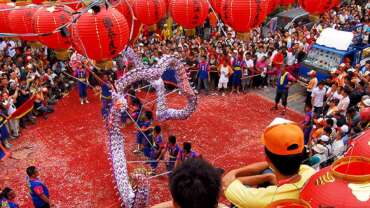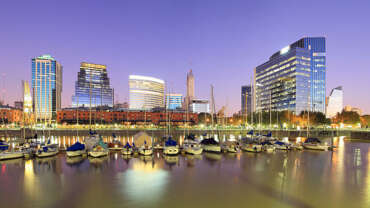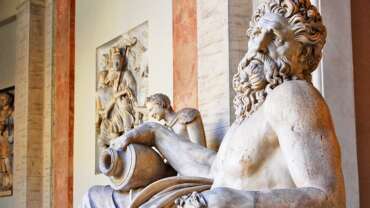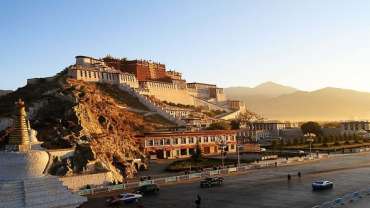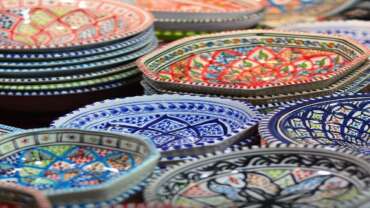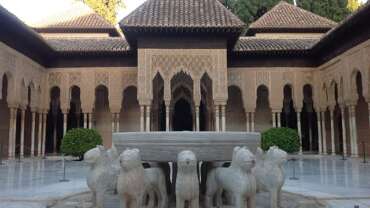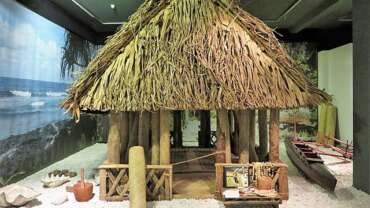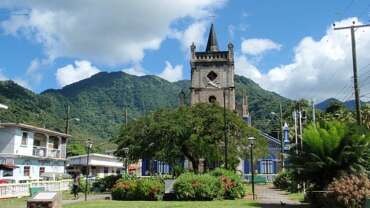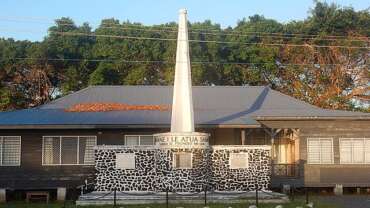Spain - Spain in Detail
Spain, country located in extreme southwestern Europe. It occupies about 85 percent of the Iberian Peninsula, which it shares with its smaller neighbour Portugal. Spain is a storied country of stone castles, snowcapped mountains, vast monuments, and sophisticated cities, all of which have made it a favoured travel destination. The country is geographically and culturally diverse. Its heartland is the Meseta, a broad central plateau half a mile above sea level. Much of the region is traditionally given over to cattle ranching and grain production; it was in this rural setting that Miguel de Cervantes’s Don Quixote tilted at the tall windmills that still dot the landscape in several places.
In the country’s northeast are the broad valley of the Ebro River, the mountainous region of Catalonia, and the hilly coastal plain of Valencia. To the northwest is the Cantabrian Mountains, a rugged range in which heavily forested, rain-swept valleys are interspersed with tall peaks. To the south is the citrus-orchard-rich and irrigated lands of the valley of the Guadalquivir River, celebrated in the renowned lyrics of Spanish poets Federico García Lorca and Antonio Machado; over this valley rises the snowcapped Sierra Nevada. The southern portion of the country is desert, an extension of the Sahara made familiar to Americans through the “spaghetti western” films of the 1960s and early ’70s. Lined with palm trees, rosemary bushes, and other tropical vegetation, the southeastern Mediterranean coast and the Balearic Islands enjoy a gentle climate, drawing millions of visitors and retirees, especially from northern Europe.
History of Spain
Pre-Roman Spain
Prehistory
Human fossils in Spain belong to modern humans (Homo sapiens), the Neanderthals (H. neanderthalensis), and even earlier members of the human lineage, possibly H. erectus or H. heidelbergensis. A large number of bones have been recovered from caves at Atapuerca, Burgos, which come from sediments that are at least 300,000 years old. Other important sites are at Torralba and Ambrona (Soria), where elephants (Palaeoloxodon antiquus) were trapped accidentally in marshy ground and their remains scavenged. From those sites were excavated shouldered points fashioned from young elephant tusks as well as hundreds of stone implements (hand axes, cleavers, and scrapers on flakes, made from chalcedony, quartzite, quartz, and even limestone) and wooden objects.
Pieces of charcoal show that fire was known and used. But H. erectus or H. heidelbergensis humans were already living in Spain as early as 1.2 million years ago, as indicated by finds at Atapuerca and by stone tools recovered from beaches in the Algarve (Mirouço), Huelva (Punta Umbria), and Cádiz (Algeciras) and the terraces of the lower Guadalquivir, Tagus, Manzanares, and Ter rivers. Choppers, angular balls, and flakes from the terraces of the Jabalón River (Ciudad Real) are older than 700,000 years and perhaps more than 1,000,000 years.
Fossils of Neanderthals were found at Bañolas (Girona) and Cova Negra (Valencia). Fully developed Neanderthals, some represented by well-preserved skulls, come from more than 10 different localities throughout Spain, including Los Casares, Carigüela, Gabasa, and Zafarraya, with a cluster in Gibraltar (Forbes’ Quarry, Gorham’s Cave, and La Genista).
The appearance of modern humans (H. sapiens) in Spain after 35,000 BCE opened a new era, during which material culture acquired an innovating velocity it never lost. Flint tools became more varied and smaller, and bone and antler were used for harpoons, spears, and ornaments. Needles from El Pendo Cave (Cantabria) hint at sewn clothing of furs and skins. Most remarkable were the intellectual achievements, culminating in the Paleolithic (Old Stone Age) caves found in the Cantabrian Mountains of northern Spain. Those caves were painted, engraved, and sculpted and visited intermittently between 25,000 and 10,000 BCE.
On the walls and ceilings are images of cold-weather animals—such as bison, mammoths, Przewalski’s horse, aurochs (wild oxen), and woolly rhinoceroses. Predators such as bears, wolverines, and lions are rarely represented, and depictions of humans are extremely scarce. Many caves (such as the group of caves at El Castillo, Cantabria) show rows of coloured dots, arrowlike marks, negative impressions of human hands, and signs interpreted as vulvas. Animals may be drawn skillfully in black outlines, like the horses at Ekain (Guipúzcoa), or painted in polychrome, as at Altamira (Cantabria), and in bichrome, as at Tito Bustillo (Asturias). Those are scenes and standard compositions, but figures are also drawn singly (Puente Viesgo, Cantabria), engraved repeatedly, or drawn on top of other representations. Although the main animals hunted for food were red deer, ibex (mountain goat), and reindeer, the most-common depictions are of aurochs, bison, and horses. Salmon, a seasonal food, was rarely drawn, and plants never appear.
Similar themes occur on portable objects made of bone and antlers and on stone plaques. At the habitation site of the cave of Parpalló (Valencia), thousands of engraved stone plaques accumulated; although their interpretation is difficult, it should be stressed that Paleolithic art follows conventions. Figures are placed formally within selected caves (probably sanctuaries), with meanings hidden from modern eyes. Paleolithic visitors left stone lamps and pine firebrands as well as footprints and hand marks on muddy surfaces in the French caves of Fontanet, Isturitz (Haristoi), and Lascaux. The complexity of the Paleolithic mental universe is demonstrated by the mortuary practice in two graves in the Cueva Morín (Cantabria), where four mutilated burials survived as casts formed by a compact greasy sediment that had replaced the bodies.
The dead were accompanied by meat offerings and ochre and buried below low mounds, on top of which ritual fires burned.
After 10,000 BCE the climatic changes accompanying the end of the last glaciation led to the disappearance of cold-tolerant game and the flooding of their grazing lands near the coasts. Hunters responded by widening their range of food and collecting quantities of marine shellfish. Such adaptations can be seen in caves as far apart as Santimamiñe (Guipúzcoa), Costalena (Zaragoza [Saragossa]), and Dos Aguas (Valencia). More than 7,500 figures painted by those hunters and gatherers are known from all over the eastern and southern Iberian Peninsula, dating from 7000 to 3500 BCE and giving tantalizing glimpses of their society. Located in the open air, usually beneath rock overhangs or in protecting hollows, are animated representations of people dancing (two women in voluminous skirts at Dos Aguas; three women in skirts and two nude ithyphallic men at the Barranco del Pajarejo, Albarracín), fighting, robbing honey, stalking red deer, and hunting wild goats. Some scenes are constructed around a narrative.
The Remigia Cave and the series of 10 cavities with outstanding paintings at the Cingle de La Gasulla (Castellón) next to it show scenes of remarkable activities; in cavity IX two matched groups of archers, led by a man sporting a headdress, are engaged in hand-to-hand combat, and nearby in the rock shelter of Les Dogues another combat pits two bands of archers rhythmically against each other at close range. Bees are depicted more than 200 times, often near hives, and in cavity IV of the Cingle de la Ermita del Barranc Fondo (La Valltorta, Castellón), a scene shows a long fibre ladder with men climbing it to reach a hive defended by oversized bees. Other well-preserved groups of paintings are found at Minateda and Alpera (Albacete) and around Bicorp (Valencia).
The craft of pottery making and the cultivation of domestic cereals and livestock that characterize the Neolithic (New Stone Age) economy in Europe reached Spain from the central Mediterranean, and perhaps from northwestern Africa, after 6000 BCE. Although agriculture and husbandry were known early in eastern and southern Spain, they were assimilated extremely slowly and irregularly. Caves and sites conveniently located for hunting, such as those around Montserrat (Barcelona) and at La Sarsa (Valencia) and Carigüela (Granada), were still preferred, and people lived in extended families or small bands. A different pattern prevailed in southwestern Spain and Portugal, where the advent of the Neolithic Period came later, between 4500 and 3800 BCE.
By 4000 BCE the first big collective tombs were being built from boulders, and by 3500 BCE funerary monuments were prominent in the landscapes of Alentejo (Portugal), Extremadura, and the Atlantic littoral. Veritable megalithic cemeteries arose around Pavia and Reguengos de Monsaraz (Alentejo).
Significant changes in technology and social organization occurred after 3200 BCE. Skills in copper working were accompanied by a tendency to live in larger village communities. Differences in natural resources and population density meant that regions developed unequally, and centres of innovation are known all around the southern and southwestern coasts of Spain and Portugal. Particularly impressive is the settlement at Los Millares (Almería), which extends over five acres (two hectares) and is protected by triple walls of stone reinforced with towers at regular intervals. A formidable barbican with arrow slits and guard chambers projected from the gateway. Those defenses stretch over 330 yards (300 metres) and cut off a triangle of land high above the Andarax River, with a cemetery of more than 70 collective tombs lying just outside the walls. On the nearby hills, 10 or 15 smaller citadels watched over the natural approaches to the village. Modest dwellings lay inside, and an especially large building was used as a workshop to melt copper and to cast objects in simple molds; the metal wastes and crucibles show that pure copper and copper mixed with a small amount of arsenic as a hardening agent were regularly selected. Mines and copper-smelting slags of this date are known from the Alhamilla highlands, less than 12 miles (20 km) to the east.
Smaller, undefended villages are known from El Barranquete and Almizaraque (Almería). The agricultural economy was based on growing wheat and barley, raising common domestic animals such as cattle, pigs, sheep, and goats, and probably tilling small areas of river bottomland, the only land plentifully watered in that arid region. Varied grave goods such as copper implements, personal ornaments, and decorated vessels for drinking and feasting (called bell beakers from their distinctive shape) indicate a stratified tribal society at Los Millares with marked inequality of riches and access to the good things in life.
The defenses and multiple forts suggest social instability and the raiding and fighting that went with it. Similar villages and their megalithic tombs are known in the western outskirts of Sevilla (Seville), eastward at the Cabezo del Plomo (Murcia), and at Vila Nova de São Pedro and Zambujal north of Lisbon (Portugal).
Many Copper Age villages had been abandoned by 2000 BCE, and Bronze Age settlement shifted to new sites, sometimes only a few hundred yards away. Steep hilltops were favoured for their inaccessibility, and in southeastern Spain the custom of burying people below the floors of their houses replaced the collective practices of the Copper Age societies. Social stratification is very marked at settlement sites such as El Argar and El Oficio (Almería), where the richest women were adorned with silver diadems while their male consorts were equipped with bronze swords, axes, and polished pottery.
At Fuente-Álamo (Almería) the elite lived apart from the village, in square stone houses with round granaries and a water cistern nearby. Such customs were practiced with less intensity on the southern Meseta, where fortified hamlets known as motillas dominated a flat landscape. In eastern and northern Spain people did not live in villages at all but lived in hamlets such as Moncín (Zaragoza) or on isolated family farms such as El Castillo (Frías de Albarracín, Teruel). In the wetter regions of Spain and Portugal, along the Atlantic coast and the Bay of Biscay, so-called castros—small settlements fortified with a deep ditch and inner bank—arose, with a flourishing bronze industry linked to southern Britain and France and a custom of burying hoards of metal tools and weapons.
Mining for copper ores was practiced at El Milagro and Aramo (Asturias), where the last miners abandoned their antler picks and levers deep in the underground galleries. Such differences in settlement patterns and customs indicate that Bronze Age Spain was not homogeneous but a social mosaic that included centralized tribal societies as well as looser associations based on smaller units. Such Bronze Age societies were prospering when Phoenician sailors reached Spain about 800 BCE.
People of Spain
Ethnic groups
Spain has been invaded and inhabited by many different peoples. The peninsula was originally settled by groups from North Africa and western Europe, including the Iberians, Celts, and Basques. Throughout antiquity it was a constant point of attraction for the civilizations of the eastern Mediterranean. From c. 1100 BCE the Phoenicians, the Greeks, and the Carthaginians began to establish settlements and trading posts, especially on the eastern and southern coasts. These outsiders found a mosaic of peoples, collectively known as the Iberians, who did not have a single culture or even share a single language. A kingdom called Tartessus, which flourished between 800 and 550 BCE, ruled much of the valley of the Guadalquivir. Elsewhere political organization was less sophisticated, consisting of a number of city-states in the coastal regions and of clans in the interior and the northwest.
The Romans
The Phoenician and Greek presence was limited to small coastal regions. The Carthaginians were the first to move inland; late in the 3rd century BCE they set out to conquer as much of the peninsula as they could. Yet their success led to intervention in Iberia from the Romans, who quickly drove out the Carthaginians and conquered much of the peninsula. The Romans, however, had to deal with a number of revolts, and it was only in 19 BCE, after almost 200 years of warfare, that they secured their rule over all of Iberia. The Romans brought Iberia under a single political authority for the first time but did not try to impose a single culture on the inhabitants. Nevertheless, much of the indigenous elite adopted Roman culture and became Roman citizens, particularly in the south and east, where the Roman presence was strongest.
The Visigoths
Roman power in Spain collapsed during the 5th century CE when a number of Germanic peoples—the Suebi, the Alani, the Vandals, and finally the Visigoths—invaded the peninsula. At the end of the 6th century, King Leovigild brought all of Spain under Visigothic rule, and his son Reccared imposed a single religion, Catholic Christianity, on the country.
The Muslims
Visigothic rule did not last long. In 711 Muslim Arabs invaded Spain from North Africa and defeated the Visigothic ruler, King Roderick. They quickly conquered almost the entire peninsula and established Muslim states in Spain that were to last until 1492.
Recent arrivals
The Muslims were the last new peoples to arrive in Spain in large numbers for many centuries. Indeed, from the 16th century on and especially during the 100 years after 1860, Spain was a country of emigration rather than immigration. This began to change in the 1980s when Spain’s new position as a highly industrialized and relatively prosperous country made it attractive to people from the developing world. For the first time since the Middle Ages, Spain received large numbers of immigrants. By the early 21st century there were several million legal foreign residents and illegal immigrants in Spain, the latter concentrated mainly in Andalusia (Andalucía), in metropolitan Madrid and Barcelona, and in the Balearic and Canary islands. Most foreign residents came from other countries of the European Union (EU) and from Latin America. Many also arrived from Morocco, often crossing the Strait of Gibraltar in small boats, and from sub-Saharan Africa, arriving often at the Canary Islands; there also are significant numbers of Asians and Europeans from non-EU countries. Since 1985 Spanish governments have passed several laws on foreigners, which have made it more difficult for people to enter Spain and easier for the authorities to deport them. Promulgated in 2000 (and subsequently modified), the Law on the Rights and Freedoms of Foreigners in Spain and Their Social Integration sought to end the restrictive policies of the previous 15 years, terminating the practice of repatriating illegal immigrants and giving legal status to any employed illegal immigrant who resided in Spain for at least two years. In 2005 legislation legalized the status of many immigrant workers. The law also gave immigrants most of the same rights as Spanish citizens (except the right to vote).
The Gitano minority
The one ethnic minority of long standing in Spain is the Roma (Gypsies), who are known in Spain as Gitanos. Their traditional language is Caló. Many of them have assimilated into the mainstream of Spanish society, but others continue to lead their traditional nomadic way of life. The Gitanos were at one time most numerous in southern Spain, and, while there continue to be large populations in Andalusian cities such as Almería, Granada, and Murcia, large communities now exist in Madrid and Barcelona as well. Flamenco, an expressive song-dance form, has long been associated with the Gitanos.
Considerable prejudice and discrimination have existed against the Gitanos in Spain and are still prevalent today. But Gitanos have begun to create their own political organizations, such as the Union of the Gitano People (Unión del Pueblo Gitano; also known as the Unión Romaní), and some have been elected to parliament. There also are government programs that promote Gitano culture.
Languages
The official language of Spain is Castilian. It is the country’s most widely spoken language, and outside Spain it is generally known as Spanish. The constitution of Spain allows for its autonomous communities to recognize their dominant regional languages and dialects as having official status along with Castilian. The statutes of 6 of the 17 autonomous communities stipulate the following “co-official” languages: Catalan in Catalonia and in the Balearic Islands, Valencian in Valencia, Galician (Gallego) in Galicia, and Euskera (Basque) in the Basque Country and in some Euskera-speaking territories of Navarra. Although not named a co-official language of Asturias, Bable (Asturian) is protected and promoted under the community’s statutes, as are local Aragonese dialects in Aragon. In addition, Aranese, spoken in the Aran Valley, is safeguarded in a provision by the region’s government, the autonomy of Catalonia. All of these languages except Euskera are Romance languages (i.e., they evolved from Latin). With no relation to any other language of the world, Euskera is what is known as a language isolate. Within their respective regions of dominance, many of the languages of Spain are taught regularly in school and are used in newspapers and radio and television broadcasts.
Castilian
Castilian, which contains many words of Arabic origin, began as a dialect spoken in northern Spain. It became the language of the court of the kingdoms of Castile and León in the 12th century, and the dominance of Castile within Spain allowed it to become the official language of the state.
There are differences in accent and, to a lesser extent, in vocabulary in Castilian as it is spoken in various regions of the country. The most significant difference is in the pronunciation of c before i or e. In northern Castile, where the language is said to be spoken in its purest form, this is pronounced as an English th; in southern and western Spain it is pronounced as an English s. The prominence of people from these latter regions in the colonization of Latin America led to their pronunciation becoming the standard in American Spanish. The Cervantes Institute promotes the Spanish language and Spanish culture in many countries.
Catalan
Catalan is closely related to Occitan (Provençal), a language spoken in southern France. It is spoken by more than four-fifths of the population in Catalonia, Valencia, and the Balearic Islands. But there are differences in the way Catalan is spoken in these three regions, and in the 1980s there were politically motivated disputes as to whether Valencian was a Catalan dialect or a distinct language. Catalan literature, which has a long and distinguished history, flourished especially during the Middle Ages. However, it declined after the 15th century before reviving again in the period known as the Renaixença (“Renaissance”), which began in the mid-19th century.
Galician
Spoken in Galicia, in the northwestern corner of Spain, the Galician language (Gallego) is closely related to Portuguese, although it has been influenced by Castilian Spanish throughout the modern period. It was the language of courtly literature until the 14th century, when it was displaced by Castilian. From then until the late 19th century, when a literary revival began, its use was limited to everyday speech, and it was more common in the countryside than in the cities due to a tradition of spoken Galician at home. Most of the population of Galicia is bilingual in Galician and Castilian.
Religion
Roman Catholicism became the official religion of Spain in 589 and has been closely identified with the country ever since. The advent of political liberalism at the beginning of the 19th century led to a series of conflicts between church and state, especially over land ownership and the control of education. Even so, Catholicism remained the official religion of the state until the Second Republic (1931–36). After the Spanish Civil War, General Francisco Franco restored it as the state religion, and it retained that status until the proclamation of the constitution of 1978. Since then Spain has had no official religion, but the Roman Catholic Church continues to receive financial support from the state. The legalization of divorce and abortion along with educational reforms in the 1980s brought the church into conflict with the government once again but with less intensity than previously.
The vast majority of the population is Roman Catholic, yet for many—and especially for those born after 1950—this has little meaning beyond being baptized, married, and buried within the church. There are several hundred thousand non-Catholic Christians in Spain. American-based denominations such as the Jehovah’s Witnesses and the Seventh-day Adventists as well as the Church of Jesus Christ of Latter-day Saints (Mormons) have been active in the country since the 1970s. In addition, there are hundreds of thousands of adherents of Islam, whose numbers have grown rapidly because of immigration. Some 100,000 Jews fled Spain during the Spanish Inquisition in the late 15th century, when the inquisitor general Tomás de Torquemada persuaded the country’s rulers to expel any Jew who refused to be baptized. To remain in the country, many Jews converted to Christianity (becoming known as conversos); those known as Marranos converted to Christianity but continued surreptitiously to practice Judaism. Restrictions on Judaism were eased only in the 20th century, and by the early 21st century there were some 15,000 Jews in Spain.
Art & Culture of Spain
The arts
Spain has a long, varied, and distinguished artistic heritage, which includes some of the most important figures in the Western cultural tradition. A partial list would include novelists Miguel de Cervantes (the most important figure of Spanish literature) and Benito Pérez Galdós, dramatists Pedro Calderón de la Barca and Lope de Vega, painters Diego Velázquez, Francisco de Goya, and Pablo Picasso, and filmmaker Luis Buñuel.
The period from about 1500 to 1681, known as the Golden Age, is considered the most brilliant era of Spain’s artistic history, with enduring contributions made in the fields of literature, theatre, architecture, and painting. Still, at no time has Spain ceased to be a culturally vital country, and the 20th century in particular proved a highly productive and creative one; indeed, its first few decades came to be called the Silver Age.
The Spanish Civil War marked a break in the development of the arts. Many leading artists and intellectuals went into exile at the end of the war. Within Spain the Franco regime practiced a sweeping censorship that limited artistic expression. Nevertheless, many Spanish artists made major contributions throughout the 20th century. Some sought inspiration in the country’s history and folk traditions; others joined the most modern currents in their fields.
Music
Spain’s contributions to world culture are many, but none has been so universally well-accepted as its musical heritage, especially that of music performed on stringed instruments. Noteworthy Spanish composers include Fernando Sor (1778–1839), Isaac Albéniz, Enrique Granados, Manuel de Falla, and Joaquín Rodrigo, all of whom drew heavily on popular and regional music for their inspiration. In the hands of Spanish composers, the guitar moved from Rom (Gypsy) folk instrument to a staple of symphonies; from Spain have come such masters as Manitas de Plata, Andrés Segovia, Paco de Lucia, and countless flamenco and classical artists of great distinction. The flamenco tradition, derived from a marriage of Arabic and Spanish folk songs, carried over into southern Spain’s unique “Rock Andaluz” movement of the 1970s and ’80s, centred in Sevilla. In the 1990s Ibiza, a popular holiday destination in the Balearic Islands, emerged as a global capital of electronic music. Electronic artists and disc jockeys from around the world converge on the island each summer to perform at night clubs and private parties, and music-related tourism has become a vital part of Ibiza’s economy.
Spain is also well represented in classical opera, with Plácido Domingo, José Carreras, Alfredo Kraus, and Montserrat Caballé among the most renowned singers. The leading classical instrumentalists of the century were cellist Pablo Casals, pianist Alicia de Larrocha, and guitarist Narciso Yepes.
Literature
Spain’s loss of its empire in Latin America following the Spanish-American War (1898) provided the impetus for many Spanish writers, poets, and scholars to restore a sense of national pride. In their work, writers such as José Ortega y Gasset, Pío Baroja, Vicente Blasco Ibáñez, and Antonio Machado y Ruiz examined Spain’s heritage and its role in the modern world. They and others who took up similar concerns came to be known as the Generation of ’98. These writers helped revitalize Spanish letters and opened the doors for Spanish cultural development in the 20th century.
Many of Spain’s 20th-century authors achieved international recognition, including five who won the Nobel Prize for Literature: dramatists José Echegaray (1904) and Jacinto Benavente (1922), poets Juan Ramón Jiménez (1956) and Vicente Aleixandre (1977), and novelist Camilo José Cela (1989).
The most famous writer of the century, however, was poet and playwright Federico García Lorca. Executed by the Nationalists in the early days of the Spanish Civil War, he became a symbol of art perishing at the hands of fascism. García Lorca’s poetry is often couched in illusive symbolism and, like his plays, draws heavily on the folklore of his native Andalusia and especially on that of the Roma (Gypsies), or Gitanos. The suppression of instinct by social convention and the repression of women are the major themes of his plays (perhaps influenced by his own homosexuality), some of which continue to be produced and which inspired two films by Spanish director Carlos Saura in the 1980s.
Among the leading poets of the last half of the 20th century were Leopoldo Panero, Luis Rosales, Blas de Otero, Gabriel Celaya, Juan Luis Panero, Andrés Trapiello, Claudio Rodríguez, José Hierro, and Pedro Gimferrer, who wrote in Catalan as well as in Castilian. Prominent women poets in the late 20th and early 21st centuries included María Victoria Atencia, known for her poetry inspired by domestic situations, for her cultivation of the themes of art, music, and painting, and for her later existentialist contemplations; Pureza Canelo, known especially for her ecological poetry and feminist volumes; Juana Castro; Clara Janés; and Ana Rossetti, noteworthy for her erotic verse. Contemporary Spanish poetry often uses colloquial language and explores intimate and social themes.
During the early 20th century many novelists experimented with form and technique and put less emphasis on plot and character. In the post-Civil War period a new generation of novelists, including Rosa Chacel, Miguel Delibes, and Carmen Laforet, avoided such experimentation and returned to a more traditional approach. Several noted writers, including Camilo José Cela, Luis Martín-Santos, and Rafael Sanchez Ferlosio, focused on postwar social problems.
The late 20th-century novel showed a variety of trends. One was the use of everyday language to tell realistic stories, often based on historical events. At the other extreme were highly intellectual novels by writers such as Juan Benet Goitia and his small group of followers. In addition, some novelists, such as Terenci Moix and, later in his career, Juan Goytisolo, were strongly drawn to non-Western cultures. Among the ranks of leading novelists were Eduardo Mendoza, Carmen Martín Gaite, José Luis Sampedro, Francisco Umbral, Javier Marías, Juan José Millàs, Antonio Muñoz Molina, and Antonio Gala. The detective novel became a popular genre after the 1970s, largely through the influence of Manuel Vázquez Montalbán; the work of his younger contemporary Arturo Pérez-Reverte, who writes both intellectual thrillers and historical novels, has been widely translated.
Cultural Life
Cultural milieu
As in much of western Europe, the culture of Spain was marked decisively by the period of Roman rule. In language, religion, even architectural traditions, the Romans left a lasting legacy. However, the subsequent course of Spanish history added elements to the country’s cultural development that were missing or much weaker in other European countries. The most important differences stem from the Arabic-speaking Muslims from the Middle East and North Africa who invaded Spain in 711 CE and dominated much of the country for almost 800 years. The Muslim cultural influence was very strong, especially in the area of language; indeed, the Spanish language has taken more words from Arabic than from any other source except Latin. Through contact with Muslims, Christian Europe was able to recover much of the cultural and intellectual heritage of Classical antiquity. It also gained access to many scientific advances made by Muslims. Spain’s cultural mix was further enriched by the presence of a large and influential Jewish population, and medieval Spain witnessed one of the periods of greatest cultural achievement in Jewish history.
During the early modern and modern periods, Spain’s culture was fairly homogeneous. The one significant exception was the presence and persistence of early languages other than Castilian in some parts of the country. Two of these, Catalan and Galician (Gallego), developed significant literary traditions during the Middle Ages. From the 16th century on, however, they lost ground to Castilian and increasingly became limited to everyday use, especially among the peasantry. This had always been the case with the third language, Euskera (Basque), which never had a significant literary tradition.
Beginning in the 19th century, all three languages enjoyed a revival. In the 20th century the Franco regime prohibited the public use of languages other than Castilian, but this did not lead to their disappearance. Instead, the use of these languages, both in daily life and in high culture, increased greatly when they became the official languages in the autonomous regions established under the constitution of 1978. They are now taught in the schools and are used in the press and on television and radio.
For much of its history, and especially after the Reconquista was completed in 1492, Spain has been strongly identified with the Roman Catholic Church. To a large extent this identification and the virtual religious monopoly that the church has enjoyed since the 16th century have been artificially imposed. Members of the two large religious minorities were forced to convert or leave the country: the Jews in 1492 and the Muslims in 1502. From 1478 until 1834 religious uniformity was enforced by the church court, the Inquisition.
In the 19th and 20th centuries the Roman Catholic Church sought to have, and for much of that time succeeded in having, the government declare Roman Catholicism as the state religion, even though a large part of the population was nonpracticing or even anticlerical. The church also encouraged the government to limit or even prohibit the practice of other faiths. State support for the Catholic church was strongest during the Franco regime, but since 1978 Spain has had no official religion. Today Spaniards enjoy complete freedom of religion, although Roman Catholicism remains an important cultural influence. Thus, at the beginning of the 21st century, the expression of cultural diversity is easier than it was for at least 500 years. Ironically, this came at the same time that Spain became increasingly drawn into a homogeneous global culture.
Daily life and social customs
Organization of the day
Daily life in early 21st-century Spain looks little different from that in other industrialized countries of the West. There remain, however, some important practices that are peculiar to Spain. The most obvious, especially for foreign visitors, is the organization of the day and the scheduling of meals. Lunch, which is the main meal of the day, is eaten between 2:00 and 3:00 PM. Traditionally it was followed by a nap—the famous siesta—but, because most people now commute between home and work, this custom is in decline. Supper, a lighter meal, is also taken late, between 9:00 and 10:00 PM, or even later during the hot summer months.
Don't miss it - Choose the travel plan you like the most to make your stay in Spain unforgettable
Solo travel is getting easier and more inviting, with more suitable destinations appearing all the time, and fewer barriers and obstacles. Solo travellers coming to Spain are in search of a unique experience, ready to enjoy all the places they discover and people they meet.
Because Spain has infinite possibilities to offer this type of traveller. So if you’re planning to travel alone in search of unforgettable experiences, we have 9 different destinations to suit your particular goals and the time available.




